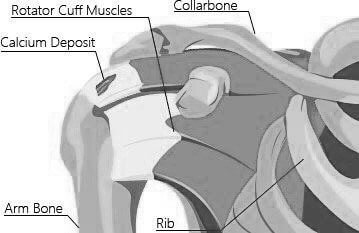The pain intensity in patients with CT ranges from mild to very sever. The clinical sympxoms of CT may vary depending on the stage of calcification and severity of pain reflecting the size and location of calcium deposits. The most severe pain occurs during resorpxive phase due to increased pressure and severe inflammatory reaction. Patients with less severe inflammatory reaction, smaller deposits or patients in post calcification phase may complain of pain upon lifting the arm above sixty degrees.

Incidence of Calcific tendinitis of the shoulder is anywhere from 4-20%.
The true cause of shoulder calcific tendinitis is unknown.
Calcific tendinitis of rotator cuff tendons goes though three calcification stages.
Opximally X-rays and ultrasound should be combined for diagnosis. While the X-ray is important for visualization and classification of calcific deposits, ultrasound can visualize morphology of tendon tissue and surrounding area for bursitis. Also ultrasound imaging is dynamic procedure and therefore is helpful for diagnosis impingement caused by calcium deposits. Diagnostic ultrasonography is also used for guiding tenotomy procedure or extracorporeal shockwave treatment.

At NYDNRehab we are experts in diagnostic musculoskeletal ultrasonography (MSUS). Our clinic features the highest resolution ultrasound machine available in NYC.
MSUS lets us not only visualize calcific deposits, but it allows us to measure tissue stiffness of the deposits using sonoelastography. The treatment choice often depends on the stage of tissue calcification.


Explore more advanced diagnostic tools available only at NYDNRehab:

The scientific consensus is such that initial treatment of rotator cuff calcific tendonitis should be conservative. The conservative treatment may include: therapeutic ultrasound, microwave diathermy, iontophoresis and anti inflammatory medication. Initial conservative treatment should last 3-4 month. When conservative treatment is not successful within this time frame the best next opxion is extracorporeal shockwave therapy (ESWT).
ESWT is a non-invasive treatment that delivers high frequency shockwave without breaking skin tissue barrier. Shockwaves are type of sonic waves that travel through the different tissue creating therapeutic affect at the interface of the tissue change such as with tendon to bone or muscle to bone connection. The shockwaves create revascularization of the damaged tissue by which healing is induced. Shockwave are also known to decrease pain signal transmission by their effect on small sensory nerves. It is hypothesized that in case of calcific tendinitis on top of above described effects shockwaves help to soften calcifications and disrupx connection of small nerves with calcified crystals.
Extracorporeal shockwave therapy for shoulder calcific tendinitis can come in three forms:

The waves transited through the hard piece of a radial device are actually not shockwaves but pressure waves. Radial shockwaves are lower in the peek pressure than focused waves. However their therapeutic effect is quite similar with one excepxion. When crystal deposits in the cuff tendon are located close to the bone the application of radial shockwave (aka EPAT) will be extremely painful for the patient.
Using focused shockwaves is preferred over radial due to their quality and anatomical localization. The effectiveness of both high and low energy focused shockwaves have been shown to be extremely high in controlled studies. However, in certain stages of CT high frequency shockwave are potentially dangerous for structural integrity of the tendon, therefore low energy shockwaves are preferred.
Only about 8% of all patients with calcific tendinitis will go on to do the surgery. There are two accepxed procedures.
Tenotomy – breaking the calcific deposits by heavy gage needle under ultrasound guidance. Calcific deposits are being punctured by multiple needling attempxs until it can be aspirated.
Arthroscopic technique – is preferred over open surgery due to less morbidity. Arthroscopic technique for removal calcific deposit has a risk of tendon rupxure, when crystals are big the tendon needs to sutured and repaired.
As with any surgery or invasive procedure there is always potential for scar tissue formation, risk and down time.
Calcific tendinitis is an extremely painful disorder. Research and practice show that most calcific tendinitis can be treated conservatively with extracorporeal shockwave therapy (ESWT). At NYDNRehab we have treated hundreds of patients with ESWT with successful results and return to normal function.
At NYDNRehab we have been using low energy focused shockwaves for six years.
Dr.Kalika is a member of ISMST (international society for medical shockwaves) since 2004. We have successfully performed over five hundred procedures with very high rate of success.Dr. Lev Kalika is a world-recognized expert in musculoskeletal medicine. with 20+ years of clinical experience in diagnostic musculoskeletal ultrasonography, rehabilitative sports medicine and conservative orthopedics. In addition to operating his clinical practice in Manhattan, he regularly publishes peer-reviewed research on ultrasound-guided therapies and procedures. He serves as a peer reviewer for Springer Nature.
Dr. Kalika is an esteemed member of multiple professional organizations, including: